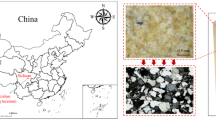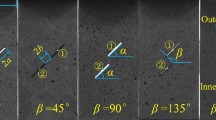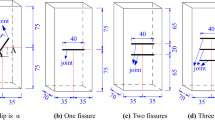Abstract
In this study, the authors combine the acoustic emission (AE) technique with the Brazilian splitting test and the angled die shear test to monitor the development of cracks in red sandstone specimens under compression–tension and compression–shear conditions to identify the mechanism of propagation of tensile and shear failures during the process of damage to rock. We use this to propose a method to analyze the comprehensive index of fracture-induced AEs of red sandstone based on information entropy. A comprehensive index to characterize the tensile and shear failures of rock was obtained by quantifying the entropy weights of the characteristic parameters of AE and their laws of evolution were analyzed. Areas for the classification of different cracking mechanisms of rock were established based on the Box–Cox transform, and the fractal features of crack development under compression–tension and compression–shear conditions were analyzed by using the Grassberger and Procaccia (G–P) algorithm. The results showed differences in the entropy of the characteristic parameters of red sandstone in cases of tensile and shear damage, with the rise time and energy recording the maximum entropies, respectively, and the amplitude yielding the minimum entropy. The comprehensive evaluation indices for tensile failure \(\xi_{t}\) and shear failure \(\xi_{\tau }\) confirmed the existence of at least two mechanisms of deformation-induced damage—tensile fracture and shear slip—in the process of damage to the rock. The curve of evolution of the fractal dimensions \(D_{t}\) and \(D_{\tau }\) of compression–tension and compression–shear, respectively, followed the law of continuously decreasing dimensions, and their turning points reflected the change in crack development in the rock.




















Similar content being viewed by others
Data Availability
Not applicable.
Materials Availability
Not applicable.
References
Jing, L.: A review of techniques, advances and outstanding issues in numerical modelling for rock mechanics and rock engineering. Int. J. Rock Mech. Min. 40(3), 283–353 (2003). https://doi.org/10.1016/S1365-1609(03)00013-3
Shiotani, T.: Evaluation of long-term stability for rock slope by means of acoustic emission technique. Ndt E Int. 39(3), 217–228 (2006). https://doi.org/10.1016/j.ndteint.2005.07.005
Aker, E., Kühn, D., Vavryčuk, V., Soldal, M., Oye, V.: Experimental investigation of acoustic emissions and their moment tensors in rock during failure. Int. J. Rock Mech. Min. 70, 286–295 (2014). https://doi.org/10.1016/j.ijrmms.2014.05.003
Mazaira, A., Konicek, P.: Intense rockburst impacts in deep underground construction and their prevention. Can. Geotech. J. 52(10), 1426–1439 (2015). https://doi.org/10.1139/cgj-2014-0359
Li, X., Gong, F., Ming, T., Dong, L., Kun, Du., Ma, C., Zhou, Z., Yin, T.: Failure mechanism and coupled static-dynamic loading theory in deep hard rock mining: a review. J. Rock Mech. Geotech. 9(4), 767–782 (2017). https://doi.org/10.1016/j.jrmge.2017.04.004
Zhou, Z., Cai, X., Li, X., Cao, W., Du, X.: Dynamic response and energy evolution of sandstone under coupled static–dynamic compression: insights from experimental study into deep rock engineering applications. Rock Mech. Rock Eng. 53(3), 1305–1331 (2020). https://doi.org/10.1007/s00603-019-01980-9
Aliabadian, Z., Zhao, G., Russell, A.R.: Crack development in transversely isotropic sandstone discs subjected to Brazilian tests observed using digital image correlation. Int. J. Rock Mech. Min. 119, 211–221 (2019). https://doi.org/10.1016/j.ijrmms.2019.04.004
Aliabadian, Z., Sharafisafa, M., Tahmasebinia, F., Shen, L.: Experimental and numerical investigations on crack development in 3D printed rock-like specimens with pre-existing flaws. Eng. Fract. Mech. 241, 107396 (2021). https://doi.org/10.1016/j.engfracmech.2020.107396
Zhou, T., Chen, J., Xie, H., Zhou, C., Wang, F., Zhu, J.: Failure and mechanical behaviors of sandstone containing a pre-existing flaw under compressive–shear loads: insight from a digital image correlation (DIC) analysis. Rock Mech. Rock Eng. (2022). https://doi.org/10.1007/s00603-022-02861-4
Gupta, N., Mishra, B.: Influence of stress-induced microcracks on viscoplastic creep deformation in Marcellus shale. Acta Geotech. 16(5), 1575–1595 (2021). https://doi.org/10.1007/s11440-020-01108-2
Ge, Y., Xie, Z., Tang, H., Chen, H., Lin, Z., Bin, Du.: Determination of shear failure regions of rock joints based on point clouds and image segmentation. Eng. Geol. 260, 105250 (2019). https://doi.org/10.1016/j.enggeo.2019.105250
Ge, Y., Xie, Z., Tang, H., Bin, Du., Cao, B.: Determination of the shear failure areas of rock joints using a laser scanning technique and artificial intelligence algorithms. Eng. Geol. 293, 106320 (2021). https://doi.org/10.1016/j.enggeo.2021.106320
Tatone, B.S.A., Grasselli, G.: Characterization of the effect of normal load on the discontinuity morphology in direct shear specimens using X-ray micro-CT. Acta Geotech. 10(1), 31–54 (2015). https://doi.org/10.1007/s11440-014-0320-5
Wang, Y., Feng, W.K., Wang, H.J., Li, C.H., Hou, Z.Q.: Rock bridge fracturing characteristics in granite induced by freeze-thaw and uniaxial deformation revealed by AE monitoring and post-test CT scanning. Cold Reg. Sci. Technol. 177, 103115 (2020). https://doi.org/10.1016/j.coldregions.2020.103115
Lotidis, M.A., Nomikos, P.P., Sofianos, A.I.: Laboratory study of the fracturing process in marble and plaster hollow plates subjected to uniaxial compression by combined acoustic emission and digital image correlation techniques. Rock Mech. Rock Eng. 53(4), 1953–1971 (2020). https://doi.org/10.1007/s00603-019-02025-x
Liu, W., Ma, L., Sun, H., Khan, N.M.: An experimental study on infrared radiation and acoustic emission characteristics during crack evolution process of loading rock. Infrared Phys. Technol. 118, 103864 (2021). https://doi.org/10.1016/j.infrared.2021.103864
Sharafisafa, M., Shen, L., Qingfeng, Xu.: Characterisation of mechanical behaviour of 3D printed rock-like material with digital image correlation. Int. J. Rock Mech. Min. 112, 122–138 (2018). https://doi.org/10.1016/j.ijrmms.2018.10.012
Sharafisafa, M., Shen, L.: Experimental investigation of dynamic fracture patterns of 3D printed rock-like material under impact with digital image correlation. Rock Mech. Rock Eng. 53(8), 3589–3607 (2020). https://doi.org/10.1007/s00603-020-02115-1
Yang, C., Zhou, K., Xiong, X., Deng, H., Pan, Z.: Experimental investigation on rock mechanical properties and infrared radiation characteristics with freeze-thaw cycle treatment. Cold Reg. Sci. Technol. 183, 103232 (2021). https://doi.org/10.1016/j.coldregions.2021.103232
Wang, C., Chang, X., Liu, Y., Guo, W.: Spectrum evolution characteristics of acoustic emission during the rupture process of marble under uniaxial compression condition. Rock Soil Mech. 41(1), 51–62 (2020). https://doi.org/10.16285/j.rsm.2019.0870
Shunchuan, Wu., Sun, W., Xueliang, Xu.: Study on mode I fracture toughness of rocks using flat-joint model and moment tensor. Theor. Appl. Fract. Mech. 120, 103403 (2022). https://doi.org/10.1016/j.tafmec.2022.103403
Zhang, Qi., Zhang, X., Yang, ShengQi: A numerical study of acoustic emission characteristics of sandstone specimen containing a hole-like flaw under uniaxial compression. Eng. Fract. Mech. 242, 107430 (2021). https://doi.org/10.1016/j.engfracmech.2020.107430
Naderlooa, M., Moosavi, M., Ahmadi, M.: Using acoustic emission technique to monitor damage progress around joints in brittle materials. Theor Appl Fract Mech. 104, 102368 (2019). https://doi.org/10.1016/j.tafmec.2019.102368
Luo, Yi., Gong, H., Kun, Xu., Pei, C., Wei, X., Li, X.: Progressive failure characteristics and energy accumulation of granite with a pre-fabricated fracture during conventional triaxial loading. Theor. Appl. Fract. Mech. 118, 103219 (2022)
Li, S., Yang, D., Huang, Z., Gu, Q., Zhao, K.: Acoustic emission characteristics and failure mode analysis of rock failure under complex stress state. Theor. Appl. Fract. Mech. (2022). https://doi.org/10.1016/j.tafmec.2022.103666
Zhang, Z., Deng, J.: A new method for determining the crack classification criterion in acoustic emission parameter analysis. Int. J. Rock Mech. Min. (2020). https://doi.org/10.1016/j.ijrmms.2020.104323
Kong, B., Wang, E., Li, Z., Wang, X., Niu, Y., Kong, X.: Acoustic emission signals frequency-amplitude characteristics of sandstone after thermal treated under uniaxial compression. J. Appl. Geophys. 136, 190–197 (2017). https://doi.org/10.1016/j.jappgeo.2016.11.008
Zhao, K., Yang, D., Gong, C., Zhuo, Y., Wang, X., Zhong, W.: Evaluation of internal microcrack evolution in red sandstone based on time–frequency domain characteristics of acoustic emission signals. Constr. Build. Mater. 260, 120435 (2020). https://doi.org/10.1016/j.conbuildmat.2020.120435
Ebrahimian, Z., Ahmadi, M., Sadri, S., Li, B.Q., Moradian, O.: Wavelet analysis of acoustic emissions associated with cracking in rocks. Eng. Fract. Mech. 217, 106516 (2019). https://doi.org/10.1016/j.engfracmech.2019.106516
Wang, C., Chang, X., Liu, Y., Chen, S.: Mechanistic characteristics of double dominant frequencies of acoustic emission signals in the entire fracture process of fine sandstone. Energies 12(20), 3959 (2019). https://doi.org/10.3390/en12203959
Kun, D., Li, X., Tao, M., Wang, S.: Experimental study on acoustic emission (AE) characteristics and crack classification during rock fracture in several basic lab tests. Int. J. Rock Mech. Min. (2020). https://doi.org/10.1016/j.ijrmms.2020.104411
Shannon, C.E.: A mathematical theory of communication. Bell Syst. Tech. J. 27(3), 379–423 (1948). https://doi.org/10.1002/j.1538-7305.1948.tb01338.x
Li, A., Deng, H., Sun, T., Wang, Y., Shu, X., Wen, J.: A time series comprehensive evaluation method of acoustic emission signal based on information entropy weighting and its application of red bed soft rock compression failure critical characteristics study. J. Build. Eng. 71, 106498 (2023). https://doi.org/10.1016/j.jobe.2023.106498
Chen, Z., Zhang, G., He, R., Tian, Z., Fu, C., Jin, X.: Acoustic emission analysis of crack type identification of corroded concrete columns under eccentric loading: a comparative analysis of RA-AF method and Gaussian mixture model. Case Stud. Constr. Mater. 18, e02021 (2023). https://doi.org/10.1016/j.cscm.2023.e02021
Wang, H., Liu, D., Cui, Z., Cheng, C., Jian, Z.: Investigation of the fracture modes of red sandstone using XFEM and acoustic emissions. Theor. Appl. Fract. Mech. 85, 283–293 (2016). https://doi.org/10.1016/j.tafmec.2016.03.012
Aggelis, D.G., Mpalaskas, A.C., Matikas, T.E.: Investigation of different fracture modes in cement-based materials by acoustic emission. Cem. Concr. Res. 48, 1–8 (2013). https://doi.org/10.1016/j.cemconres.2013.02.002
Aggelis, D.G., Mpalaskas, A.C., Ntalakas, D., Matikas, T.E.: Effect of wave distortion on acoustic emission characterization of cementitious materials. Constr. Build. Mater. 35, 183–190 (2012). https://doi.org/10.1016/j.conbuildmat.2012.03.013
Aggelis, D.G.: Classification of cracking mode in concrete by acoustic emission parameters. Mech. Res. Commun. 38(3), 153–157 (2011). https://doi.org/10.1016/j.mechrescom.2011.03.007
JCMS-III B5706: Monitoring Method for Active Cracks in Concrete by Acoustic Emission. Federation of Construction Materials Industries, Japan (2003)
Du, K., Li, X., Tao, M., Wang, S.: Experimental study on acoustic emission (AE) characteristics and crack classification during rock fracture in several basic lab tests. Int. J. Rock Mech. Min. 133, 104411 (2020). https://doi.org/10.1016/j.ijrmms.2020.104411
Farhidzadeh, A., Salamone, S., Singla, P.: A probabilistic approach for damage identification and crack mode classification in reinforced concrete structures. J. Intell. Mater. Syst. Struct. 24(14), 1722–1735 (2013). https://doi.org/10.1177/1045389X13484101
Dong, L., Zhang, Y., Bi, S., Ma, J., Yan, Y., Cao, H.: Uncertainty investigation for the classification of rock micro-fracture types using acoustic emission parameters. Int. J. Rock Mech. Min. 162, 105292 (2023). https://doi.org/10.1016/j.ijrmms.2022.105292
Grassberger, P., Procaccia, I.: Characterization of strange attractors. Phys. Rev. Lett. 50, 346 (1983). https://doi.org/10.1103/PhysRevLett.50.346
Zhang, J.: Fractal, 2nd edn. Tsinghua University Press, Beijing (2011)
Xie, H., Chen, Z.: Fractal geometry and fracture of rock. Acta Mech. Sin. 20, 264–271+290 (1988)
Chang, X.: Multi-Parameter Coupling Analysis of Acoustic Emission in Different Rock Failure [Dissertation]. Inner Mongolia University of Science and Technology, Inner Mongolia Autonomous Region (2020)
Abarbanel, H.: Analysis of Observed Chaotic Data. Springer, New York (1996)
Zhou, S., Wang, X., Zhou, W., Zhang, C.: Recognition of the scale-free interval for calculating the correlation dimension using machine learning from chaotic time series. Physica A 588, 126563 (2022). https://doi.org/10.1016/j.physa.2021.126563
Zeng, P., Liu, YangJun, Ji, H., Li, C.: Coupling criteria and precursor identification characteristics of multi-band acoustic emission of gritstone fracture under uniaxial compression. Chin. J. Geotech. Eng. 39(03), 509–517 (2017)
Qiang, Fu., Li, C., Zhang, C.: G-P algorithm for evaluating the correlation dimension in chaos. J. PLA Univ. Sci. Technol. (Nat. Sci. Ed.) 15(03), 275–282 (2014)
Qiao, M., Ma, X.: A new method on solving correlation dimension of chaotic time-series. In: Proceedings of the 10th World Congress on Intelligent Control and Automation, pp. 4820–4824. IEEE (2012)
Dang, J., Huang, J.: Study of the parameters used in calculating correlative dimension based on G.P algorithm. Appl. Res. Comput. 2004(1), 48–51 (2004)
Acknowledgements
Not applicable.
Funding
This work supported is by the National Natural Science Foundation of China (No. 51934003), Innovation Team, Yunnan Province, China (No. 202105AE160023), and Major Scientific and Technological Projects, Yunnan Province, China (No. 202202AG050014).
Author information
Authors and Affiliations
Contributions
Xinke Chang: Methodology, software, formal analysis, investigation, writing—original draft. Shunchuan Wu: Resources, writing—review and editing, supervision, data curation. JiaXin Wang: Resources, Writing—review and editing, supervision, data curation. Xin Fu: Investigation, writing—review and editing.
Corresponding author
Ethics declarations
Competing interests
The authors declared that they have no conflict of interest.
Ethical Approval
Not applicable.
Consent to Participate
Not applicable.
Consent for Publication
Not applicable.
Additional information
Publisher's Note
Springer Nature remains neutral with regard to jurisdictional claims in published maps and institutional affiliations.
Rights and permissions
Springer Nature or its licensor (e.g. a society or other partner) holds exclusive rights to this article under a publishing agreement with the author(s) or other rightsholder(s); author self-archiving of the accepted manuscript version of this article is solely governed by the terms of such publishing agreement and applicable law.
About this article
Cite this article
Chang, X., Wu, S., Wang, J. et al. Investigating the Comprehensive Index of Acoustic Emissions and Fractal Characteristics of Damage of Red Sandstone Based on Information Entropy. J Nondestruct Eval 43, 36 (2024). https://doi.org/10.1007/s10921-024-01051-2
Received:
Accepted:
Published:
DOI: https://doi.org/10.1007/s10921-024-01051-2




